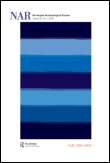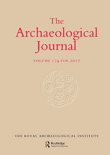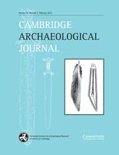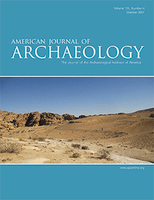
Norwegian Archaeological Review
Scope & Guideline
Exploring the Past, Illuminating the Future
Introduction
Aims and Scopes
- Interdisciplinary Approaches to Archaeology:
The journal encourages the integration of various disciplines, such as anthropology, history, and art history, to enrich archaeological research and broaden perspectives on ancient societies. - Focus on Nordic Archaeology:
A significant emphasis is placed on the archaeology of Scandinavia and surrounding regions, exploring historical periods from the Bronze Age to the Medieval era, and how these periods interconnect. - Material Culture and Human Interaction:
Research often revolves around material culture, examining how artifacts, landscapes, and human interactions shape and reflect social identities, practices, and beliefs. - Critical Theoretical Perspectives:
The journal promotes critical engagement with archaeological theory, encouraging discussions on post-colonialism, gender studies, and the politics of heritage, which help frame contemporary archaeological discourse. - Public Engagement and Heritage Studies:
There is a focus on the relationship between archaeology and public understanding, emphasizing the importance of heritage studies in contemporary society and how archaeology can inform modern cultural dialogues.
Trending and Emerging
- Experiential and Engaged Archaeology:
There is a rising interest in experiential archaeology, emphasizing the importance of fieldwork and active engagement with archaeological sites to enhance understanding and interpretation. - Gender and Identity in Archaeology:
Research addressing gendered narratives and identity formation in past societies is increasingly prevalent, reflecting a broader trend towards inclusivity and diverse perspectives in archaeological discourse. - Colonialism and Post-Colonial Studies:
A significant trend is the examination of colonial legacies in archaeology, with scholars exploring how historical narratives and practices have been shaped by colonialism and advocating for decolonization in archaeological methodologies. - Mobility and Migration Studies:
The study of mobility and migration narratives is gaining traction, as researchers seek to understand the dynamics of movement and cultural exchange in ancient societies, particularly in the context of the Nordic regions. - Environmental Archaeology:
Emerging themes in environmental archaeology are becoming more prominent, focusing on human-environment interactions and the impact of climatic changes on past societies, which is vital for understanding resilience and adaptation.
Declining or Waning
- Traditional Artifact Typologies:
Research centered solely on traditional artifact typologies has become less frequent, as the field moves towards more nuanced understandings of artifacts through their contextual and relational aspects. - Classic Historical Narrative Approaches:
There has been a noticeable decline in studies that adhere strictly to classical historical narratives, as contemporary archaeology increasingly embraces more complex, non-linear interpretations of the past. - Isolated Regional Studies:
Papers focusing exclusively on isolated regional studies without connection to broader themes or interdisciplinary approaches are becoming less common, reflecting a shift towards more integrative research methodologies. - Static Interpretations of Ritual Practices:
The exploration of ritual practices is evolving, with less focus on static interpretations. Researchers are now more interested in the dynamic and evolving nature of rituals rather than fixed meanings. - Conventional Excavation Reports:
There is a decreasing emphasis on conventional excavation reports that lack theoretical framing or broader implications, as the journal favors studies that connect findings to larger archaeological questions.
Similar Journals

Archaeological Journal
Advancing Knowledge, Preserving Our PastArchaeological Journal, published by Taylor & Francis Ltd, stands as a leading voice in the field of archaeology, with a remarkable distinction in the Q1 category for both arts and humanities as well as conservation, underscoring its critical role in advancing scholarly dialogue and research. With an ISSN of 0066-5983 and E-ISSN of 2373-2288, this journal provides a platform for innovative research from 1977, now offering insights up to 2024. The United Kingdom-based journal is highly regarded, being within the top 81st percentile in archaeology and conservation according to Scopus rankings. Essential for researchers, professionals, and students, the journal's content spans rigorous archaeological studies, theoretical advancements, and discussions on conservation practices, ultimately aimed at fostering a deeper understanding of humanity's past. Notably, with no open access option, it maintains a traditional publishing approach, thereby ensuring curated and high-quality contributions to the academic community.

Slovenska Archeologia
Exploring the depths of Slovakia's rich archaeological heritage.Slovenska Archeologia is a prominent journal published by the Slovak Academy of Sciences, Institute of Archaeology, dedicated to advancing the field of archaeology through rigorous scholarly research and insightful scholarship. With an ISSN of 1335-0102 and an E-ISSN of 2585-9145, this journal has been a vital platform for archaeologists and academics since its inception, converging its insightful publications from the years 2017 to 2023. Awarded a Q2 ranking in the field of archaeology across both arts and humanities categories, it holds a respectable position in the Scopus rankings, recognizing its contributions to the discipline. Based in Slovakia, the journal is an essential resource for professionals, researchers, and students interested in archaeological findings and methodologies. While it does not currently offer Open Access options, its commitment to promoting high-quality research makes it a valuable addition to the academic community.

ANTIQUITY
Connecting Scholars to the Legacy of HumanityANTIQUITY is a prestigious academic journal published by Cambridge University Press that has been at the forefront of archaeological and humanities scholarship since its inception in 1927. With its roots firmly planted in the United Kingdom, the journal has achieved remarkable recognition, maintaining a Q1 ranking in both the fields of Archaeology and Arts and Humanities as of 2023. With an impressive Scopus ranking of #3 out of 173 in General Arts and Humanities and #28 out of 354 in Archaeology, it underscores its significant impact and influence in shaping contemporary discourse in these domains. Although it is not an Open Access journal, ANTIQUITY provides crucial insights into the evolution of human societies through a comprehensive range of archaeological studies, reviews, and theoretical discussions. By facilitating knowledge exchange among researchers, professionals, and students, ANTIQUITY not only enriches academic literature but also fosters a deeper understanding of our past.

Prilozi Instituta za Arheologiju u Zagrebu
Illuminating the archaeological landscape with impactful research.Prilozi Instituta za Arheologiju u Zagrebu is a prominent academic journal published by INST ARHEOLOGIJU, dedicated to advancing the field of archaeology and related historical studies. Operating in Croatia, this journal serves as a vital platform for scholars, researchers, and students to disseminate innovative research and insights within the realm of archaeology, with a focus on the rich cultural heritage of the region. The journal spans contributions from 2002 to 2011 and has ongoing publication since 2013, reflecting its commitment to contemporary archaeological discourse. With a growing reputation, it has achieved a Q3 ranking in the fields of Archaeology and Arts and Humanities, and a Q2 ranking in History, signifying its impact and relevance in the academic community. Although Open Access options are not available, the journal remains an essential resource for those pursuing in-depth knowledge and research in archaeology. Researchers can harness the journal's extensive scope to explore critical historical narratives and archaeological findings, solidifying its importance in both local and global contexts.

Bulgarsko e-Spisanie za Arkheologiya-Bulgarian e-Journal of Archaeology
Connecting scholars to the past, present, and future of archaeology.Bulgarsko e-Spisanie za Arkheologiya - Bulgarian e-Journal of Archaeology is a prominent open-access journal published by the ASSOC BULGARIAN ARCHAEOLOGISTS since 2011, serving as a vital platform for the dissemination of archaeological research and findings in Bulgaria and beyond. With the ISSN 1314-5088, this journal is dedicated to advancing knowledge in the field of archaeology, facilitating the sharing of innovative studies, fieldwork results, and theoretical discussions. It is particularly significant for researchers, professionals, and students who are interested in the archaeological heritage of Bulgaria, providing an accessible venue for high-quality scholarly contributions. The journal's commitment to open access ensures that its rich repository of knowledge is available to a global audience, enhancing collaboration and fostering new discoveries within the discipline.

Pamatky Archeologicke
Fostering innovation in the understanding of prehistory and heritage.Pamatky Archeologicke is a premier journal dedicated to the field of archaeology, published by the Academy of Sciences of the Czech Republic, Institute of Archaeology. Renowned for its rigorous scholarship and insightful contributions, the journal holds a distinguished position within the academic community, featured in the Q1 category of both archaeology and arts and humanities as of 2023. With impactful research articles that span a broad spectrum of archaeological inquiry, Pamatky Archeologicke serves as an essential resource for researchers, professionals, and students dedicated to understanding cultural heritage and archaeological methodologies. The journal enjoys a significant Scopus ranking, having achieved an impressive percentile ranking in both arts and humanities and social sciences disciplines. Although it currently does not offer open-access options, the journal remains committed to advancing the field of archaeology through high-quality research and critical discussions. Its scholarly contributions are crucial for fostering knowledge and innovation in the understanding of human history and prehistory.

Cuadernos de Prehistoria y Arqueologia-Universidad Autonoma de Madrid
Elevating Scholarly Excellence in Prehistoric InquiryCuadernos de Prehistoria y Arqueologia-Universidad Autonoma de Madrid is a distinguished academic journal dedicated to the fields of archaeology and prehistory, published by the Universidad Autonoma de Madrid, Departamento de Prehistoria y Arqueología. With an ISSN of 0211-1608, this journal plays a crucial role in disseminating significant research findings and theoretical advancements within these domains. Recognized for its scholarly excellence, it holds impressive quartile rankings in 2023, including Q2 in Archaeology and Q1 in History, reflecting its high impact within the academic community. While currently not an open-access publication, Cuadernos de Prehistoria y Arqueologia provides valuable insights to researchers, professionals, and students engaged in the exploration of human history and cultural heritage from 2018 to 2024 and beyond. With a commitment to fostering interdisciplinary dialogue, this journal serves as an essential platform for innovative studies and comprehensive reviews, contributing to the advancement of knowledge in archaeology and prehistory.

CAMBRIDGE ARCHAEOLOGICAL JOURNAL
Exploring the Depths of Human HistoryThe Cambridge Archaeological Journal, published by Cambridge University Press, is a premier academic journal dedicated to archaeology and cultural studies. With an ISSN of 0959-7743 and an E-ISSN of 1474-0540, it has established itself as a leading platform since its inception in 1991, showcasing groundbreaking research that significantly contributes to our understanding of human history and cultural heritage. The journal currently ranks in the top quartile (Q1) across various categories, including Archaeology and Cultural Studies, underlining its impact and relevance in the field. The impact factor reflects its esteemed position, with Scopus ranks placing it within the 90th to 93rd percentiles among its peers. Researchers, professionals, and students alike benefit from its insightful analyses and interdisciplinary approaches, making it an essential resource for advancing knowledge in archaeology and related fields. The journal is based in the United Kingdom, at the Edinburgh Building, Shaftesbury Rd, CB2 8RU, Cambridge, England, and continues to drive scholarly conversations through its commitment to excellence and innovation in archaeological studies.

AMERICAN JOURNAL OF ARCHAEOLOGY
Transforming Excavations into Global KnowledgeThe American Journal of Archaeology (ISSN: 0002-9114, E-ISSN: 1939-828X), published by the esteemed University of Chicago Press, stands as a leading scholarly journal in the field of archaeology, celebrated for its rigorous peer-reviewed research. With an impressive impact factor that places it in the Q1 quartile for both archaeology and archaeology within the arts and humanities, this journal ranks among the top 15% in its field, according to Scopus metrics. It serves a global audience of researchers, professionals, and students, facilitating the dissemination of innovative findings from excavations, historical analyses, and methodological advancements. While primarily available through subscription, the journal's archives and features provide invaluable resources for deepening one's understanding of the past and engaging with current archaeological discourse. Operating from its home in Chicago, USA, the American Journal of Archaeology actively contributes to the advancement of knowledge and scholarship in archaeology, making it an essential platform for those invested in the exploration of ancient civilizations and cultural heritage.

Stratum Plus
Innovating Research Across Cultures and ErasStratum Plus, published by HIGH ANTHROPOLOGICAL SCH UNIV, is a distinguished academic journal based in Moldova that focuses on the fields of Anthropology, Archeology, and History. With an impressive impact factor reflecting its stature—ranked in the Q2 category for both Anthropology and Archeology, and Q1 for Archeology in the arts and humanities—this journal is a vital resource for scholars, professionals, and students alike. The journal's comprehensive scope encompasses a wide array of interdisciplinary studies, making it a beacon for innovative research and critical discourse within these disciplines. Since its inception in 2014, Stratum Plus has strived to foster academic excellence and knowledge dissemination, thus playing a crucial role in shaping contemporary anthropological and archaeological thought. While currently not available as Open Access, the journal maintains a strong online presence, with access options available through institutional subscriptions. Located at ZIMBRULUI 10A ST, KISHINEV MD-2024, MOLDOVA, Stratum Plus invites contributors and readers to engage with cutting-edge research that continues to enrich the global academic community.